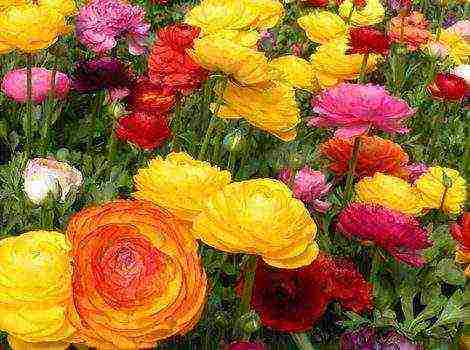Content
- 1 Hello dear readers!
- 2 Growing onion sets
- 3 Onion-turnip from seeds in one year
- 4 What is the difference between chives bow
- 5 Preparing a site for planting chives
- 6 How to grow chives from seeds outdoors
- 7 Onion chives growing from seeds for seedlings in a snail photo and video
- 8 Dividing the chives onion bush
- 9 How to care for chives outdoors
- 10 Harvesting
- 11 Chives varieties
- 12 Diseases and pests of onion chives
- 13 Growing onion sets from seeds
- 14 Another way to grow onions
- 15 Onion from onion sevka
- 16 How to grow onions from seeds in one season
- 17 Growing onion seedlings from seeds at home.
Hello dear readers!
Let's continue the conversation about growing onions and in this article I want to tell you about growing onions from seeds.
There are three ways growing onions from seeds:
- first - we grow onion sets, and already from it the next year - turnip onions;
- the second - in one year we get turnip onions directly from seeds, planting them either very early in spring, or by seedlings;
- the third is winter sowing.
But first of all, before we start sowing seeds, let's decide what varieties we will plant.
The method of cultivation and the timing of planting largely depend on this. Now in Russia there are more than 60 varieties of onions, which can be divided into two groups: varieties of northern origin and varieties of southern origin.
Northern varieties need 16-17 hours of day length to form a full-fledged bulb, while southern varieties need 13-14 hours long.
Therefore, if we plant northern varieties in the south, then we may not get the bulbs. Southern varieties require more heat and have a longer growing season.
Also keep in mind that the northern onion tastes spicier and can be stored very well until the next harvest if stored properly.
Southern varieties have excellent taste, but they are stored for a much shorter time.
Most of the Russian onion varieties are long day onions. These are such varieties as: Strigunovsky, Bessonovsky, Arzamassky, Myachkovsky, Danilovsky, Rostovsky, Odintsovets and others.
Of the varieties of foreign selection, I recommend - Stuttgarter Riesen, Globo, Densimore, F1 hybrid Bonus.
And if you want to grow salad onions, then you can plant such southern varieties as: Spanish-313, Karatalsky, Lugansky, Krasnodar G-35, Kabo.
Growing onion sets
In the previous article, questions about the basic requirements for growing onions and preparing a plot for onions were highlighted, so we will not return to them, but proceed directly to the pre-sowing preparation of seeds and their planting.
Landing dates. First of all, we decide on the landing date, this is one of the most important points. Sowing is carried out as soon as the soil allows, because even with a slight (especially in dry years) delay with sowing, both the field germination of seeds and the yield and quality of seedlings are reduced. In this case, onion sets ripen very poorly and, most importantly, are not stored for a long time.
In central Russia, planting is best done in the last decade of April, if the weather does not bring any surprises.
And one more thing, although it is believed that nigella (also called onion seeds) retains its germination without loss for 2 years, but I advise you to still use annual seeds.
Seed preparation. First of all, let's check the seeds for germination, for this we place a few pieces of seeds between layers of damp cloth and put in a warm place.If after a while sprouts appear, then you can start preparing for sowing.
Next, we determine whether treatment is necessary for our seeds: the seeds that we buy in specialized stores have basically all already been disinfected (although there are exceptions), but the seeds that you yourself have grown, it is advisable to treat with any fungicidal dressing agents.
Or you can use a weak solution of potassium permanganate for this and keep the seeds in it for one day. It is very good to warm up the seeds for 30 minutes in hot water with a temperature of about 50 degrees, and also soak them in aloe juice for 30-40 minutes.
To speed up the emergence of seedlings (onion seeds germinate very slowly), soak the seeds in water at room temperature. This must be done 3-4 days before sowing.
Pour the seeds into a cloth bag, filling it in half, tie it and put it in water for 30-35 hours. During this period of time we change the water 3-4 times.
Then we sprinkle the already swollen seeds with a thin layer on a damp cloth, cover them on top with a second layer of damp cloth and leave them warm.
After two days, the seeds will begin to hatch and you can start sowing, but after we dry the nigella a little so that it becomes free-flowing, we mix it with chalk so that the seeds are better visible on the dark ground.
Sowing seeds. Sowing is carried out in a belt manner on a bed about 1 meter wide with very loose soil. Loose soil when sowing nigella is necessary because it will be very difficult for an onion sprout, which has the shape of a loop, to break through to the surface if we have dense soil or if we deeply bury the seeds in the ground.
In this regard, we sow seeds in grooves with a depth of 1.5-2 cm.It is advisable to maintain the distance between the seeds 1-1.5 cm.
The seeding rate of seeds is very important, since the growing season of the seed, as well as the quantity and quality of the crop, depends on it.
If we sow seeds rarely, then a large seed (samples) will grow, which will not have enough time for ripening.
If we sow the seeds often, we will get an immature small seed (non-standard), which is poorly stored and begins to germinate early.
Then we carefully close the grooves, compact the soil so that there are no air chambers between it and the seeds.
We mulch a bed with sown onion seeds with peat or humus with a layer of about 2 cm, and then water it carefully, trying not to blur the planting.
After that, it is advisable to cover the bed with plastic wrap in order to create a favorable water and air regime for the early germination of seeds. After emergence, the film must be removed.
Crop care. First of all, you need to carefully monitor so that a soil crust does not form and remove all weeds in a timely manner. If we have weeds on crops during the germination period, then the yield of onions decreases to 50%, and the ripening of the bulbs is very noticeably delayed.
With the formation of a soil crust, onion shoots are sparse and uneven, which also leads to a decrease in yield and a deterioration in its quality.
Sometimes weeds appear before onion shoots and there may be a danger of destruction of onion seedlings when weeding and loosening.
To prevent this, it is very good to add a little lettuce or radish seeds to the nigella seeds when sowing. They will emerge first and show us the location of the onion rows, and after the onion shoots, the beacon plants can be removed.
When the seedlings have 1-2 true leaves, we carry out the first thinning of crops in highly thickened places, leaving 1.5-2 cm between the plants.We carry out the second thinning after the formation of 3-4 leaves and leave a distance of 4-6 cm between the plants.
I would like to draw your attention to the fact that both weeding and thinning should not be delayed in any case, since otherwise thickening accelerates the formation of bulbs, the plants do not have time to form a sufficient number of leaves and the bulbs are small.
Water the onion plantings 1-2 times a week, provided the weather is dry, and only in the first half of the growing season (May - June). Then we stop watering, as the bulbs are ripening.
And 1 week before harvesting, it is recommended to carry out foliar feeding of crops with potash fertilizer, as this contributes to better ripening of the seedlings.
Harvesting, preparation for storage and storage features. We start harvesting onion sets in the second half of July - August (depending on the weather), as soon as the leaves turn yellow by a third of the height.
You can read about harvesting onions and preparing them for storage in the previous article on onions.
It is necessary to store the grown onion sets in different ways, depending on its size. Therefore, the first step is to sort it into small ones up to 1.0 cm in diameter, medium - 1.5-2.5 cm and large - more than 3 cm.
Sevok is best stored in cloth bags and in a dry, well-ventilated area. For shallow seedlings, the optimal storage temperature is 0 ° C, because since it is prone to drying out, at a higher temperature such onions can completely die.
The problem of storing small sets (non-standard) can be solved by planting it before winter, because it does not shoot under any conditions and can give an excellent harvest of turnip onions.
Medium and large seedlings keep well at room temperature (up to 18 ° C). At higher or lower storage temperatures, the onion sets may go to the arrow after planting.
Onion-turnip from seeds in one year
It is quite possible to grow onions from seeds in one year. Our resourceful summer residents have learned to do this very successfully, using two methods: firstly, the early spring thickened sowing of seeds; secondly, it is growing through seedlings.
The most suitable varieties for such onion cultivation are considered Myachkovsky, Strigunovsky and Odintsovets... The varieties are also good Russian size and Exibition, which have very large bulbs (350 g, and sometimes up to 500 g) of a delicate, sweet taste.
Now let's take a closer look at each method.
Early spring landing. Early varieties are most suitable for growing onions in this way, and onions grown in this way will not be stored for so long, so it is best to use them first.
It is recommended to start sowing around April 20-25 (we look at the weather). We warm the seeds, disinfect, germinate and sow very early on the beds prepared in the fall.
The beds should be covered with plastic wrap in advance so that the ground warms up well before planting the seeds.
On the day of planting, we remove the film from the garden, make grooves and spill them with hot water. Then we spread the seeds, sprinkle them with humus or compost, compact the soil and cover the bed again with foil.
We remove the film from the garden only when shoots appear.
Further planting care is the same as for onions, which we grow from sets. The only difference is the need for planting thinning.
The first time the onion should be thinned when it reaches 7-10 cm. The second thinning is carried out after 3 weeks and the third - 2-3 weeks after the second.
As a result, the distance between the bulbs should be about 10 cm. With this method of growing onions, it is very important that the bulbs have time to fully ripen.
To somehow speed up this process, you can do the following:
- In the second half of the growing season, undo the bulbs so that they are half above the ground.
- Pull the bulbs slightly by the feather, as if lifting them in the ground, or slightly prune the roots with a shovel.
With these actions, the process of supply of nutrients from the leaves to the bulbs is significantly accelerated and their ripening is faster.
Some summer residents, in order to accelerate ripening, crush onion leaves, but this method is dangerous because pathogenic bacteria or pests can get into the neck of the bulb.
With this method of planting, it is quite possible that not only onions will grow from seeds, but also onions and onions. Therefore, after harvesting and drying the onion, it must be sorted into large (more than 4 cm), medium (3-4 cm) and small (up to 3 cm).
Then we leave large bulbs for winter storage; medium onions must be consumed first, they are also suitable for forcing green onions; small bulbs (sets) we leave for storage for spring plantings.
Onions through seedlings. Growing onions through seedlings is, of course, troublesome, but not difficult. But there are many advantages: firstly, the onion ripens perfectly by the fall, not at all worse than planted with a set; secondly, at the same time, we get a yield twice as large as when sowing seeds directly into open ground.
We sow seeds for seedlings at the end of February - the first half of March. We grow onion seedlings at home in boxes, seedling pots or other containers with a height of at least 10 cm.
The main condition is that the walls of the containers should not be transparent, as light will interfere with the development of the root system.
Seeds can be sown into 1 cm deep grooves or simply planted densely over the entire area of the container.
Then we cover them with a layer of earth (1 cm) on top, slightly compact, carefully water (preferably from a spray bottle, so as not to wash the seeds out of the soil) with warm water and put the container in a warm place (22-25 ° C), covered with a film.
After about 10-15 days, shoots begin to appear and the film is removed. After the emergence of sprouts (loops), the containers with seedlings are placed in the brightest place, while it is desirable to maintain the air temperature at 9-12 ° C for 3-5 days.
Then it is recommended to increase the temperature to 15-20 ° C during the day and 10-12 ° C at night. If the air temperature in the room is higher, then regular ventilation is necessary so that the seedlings do not stretch out and do not get sick with a black leg.
In addition, if the seedlings grew at an elevated temperature, then later, when planted in the ground, they do not take root well.
Water the seedlings of onions sparingly, do not overmoisten the soil. Before planting the seedlings in the ground, we feed it two times, but if it grows strong and healthy, then you can feed it once.
We carry out the first feeding one week after germination, and the second two weeks after the first.
A solution for dressing can be prepared from both mineral fertilizers and mullein infusion by stirring in water in a ratio of 1: 6.
We feed very carefully - little by little.
At the age of about 60 days, the seedlings can already be planted in the garden. By this time, it becomes strong, has a developed root system, 3-4 true leaves and a thickness of 3-4 mm at the base.
Usually, onion seedlings are planted in the vegetable garden from May 1 to May 10, depending on the weather in the region and on the condition of the soil. She is not afraid of small frosts.
The best time to plant is in the afternoon, when the air temperature is already starting to drop. Before transplanting, water the seedlings well, then carefully remove each plant from the ground.
If the roots are long, then they need to be shortened a little, by about one third. This is done so that when planting, the roots do not bend upwards, since the plant survival rate decreases.
We plant onions in rows with a distance between plants of 8-10 cm, between rows - 20-25 cm.If you are planting large varieties of onions, it is better to adhere to the scheme of 30x30 cm.Immediately after planting, we water the garden well.
In the future, during the first week, until the plants take root, we water every day, keeping the earth moist. Then watering should be carried out as the soil dries out.
The following agrotechnical measures are no different from those that are used in the cultivation of onions in other ways, namely: weeding, watering, loosening, feeding, harvesting.
On this, perhaps, the article will end.In it, I told you about growing onions from seeds in two ways: by a two-year culture - we grow onion sets, and already from it the next year - onion-turnip and one-year old - in one year we get turnip onions directly from the seeds, planting them either very early spring, or seedlings.
We will talk about the third method - sowing podzimm - in one of the subsequent articles.
See you soon, dear readers!
You can also read on this topic:
Tags: onion
Chives, chives, Siberian onions, chives are a perennial plant of the Onion family. In the natural environment, it grows in India, Asia, European countries, and is widespread on the coast of the North Sea.
What is the difference between chives bow
Chives are grown for feathers. The bulb is covered with special membranous membranes, due to which the culture successfully hibernates in open ground. In early spring, when the snow melts, it is enough to clear the area of old leaves - and young shoots will not be long in coming. Do not pinch the greens (the bush will start to hurt), but cut with scissors. Then water to make new greens appear faster.
Leaves-feathers are fragrant, will give a delicate taste to any dish. They are rich in useful substances: phytoncides (capable of preventing the spread of infections), amino acids (tryptophan, lysine, methionine), contain a huge amount of vitamin C, mineral salts. Eating chives onions helps to normalize the functioning of the kidneys and heart.
In addition, chives are a honey plant and a real decoration of the site, often planted as an ornamental flowering culture.
Another advantage of chives is the ability to grow greens indoors on a windowsill.
Preparing a site for planting chives

What does a chives onion look like?
Chives will grow well in a well-lit area, but the leaves stay tender for longer when shaded. The ideal planting site is partial shade, where it is cooler and more humid.
The best predecessors: cucumbers, radishes, potatoes, tomatoes; not desirable neighborhood with beets, cabbage, legumes.
The soil must be cultivated in order to obtain rich and stable yields. Dig up the area 2-3 weeks before planting. If the soil is heavy, clayey, apply fertilizers (humus or compost) for digging.
How to grow chives from seeds outdoors
Chives are propagated by seeds and vegetatively.
The culture is cold-resistant, therefore, sowing seeds can be carried out directly into open ground without growing seedlings.
When to sow chives in the ground
Spring sowing spend in April-May. Soak the seeds in warm water or, better, manganese solution before planting. Sow into grooves. Cover the seeds to a depth of 1 cm. Maintain a row spacing of 30 cm.
Seedlings will appear in 7-10 days. When 1 leaf is formed, thin out the plantings, leaving a distance between individual plants of 8-10 cm, when the onion grows up, it is thinned out to a distance of 25-30 cm (extra bushes are transplanted).
Sowing before winter spend in November - you do not need to pre-process the seeds, they will undergo natural stratification in the soil. The seeding depth should be 2 cm. It is better to roll the crops, mulch with peat or humus.
Onion chives growing from seeds for seedlings in a snail photo and video
When to sow chives for seedlings? Sowing is done in March. It is very convenient to plant onion chives with seeds in a snail: this is a good time and space saving on the windowsill. Seeds are placed every 1-2 cm and lightly sprinkled with earth on top. The video shows how to twist a snail for seedlings:
Further care for seedlings in a snail is very simple: you need to moisten the ground from a spray gun and provide bright diffused lighting. Seedlings are constantly pruned at a height of 10 cm and grown until early May, when they can be planted in the ground. Before planting in the ground, the seedlings are hardened for 10-12 days.
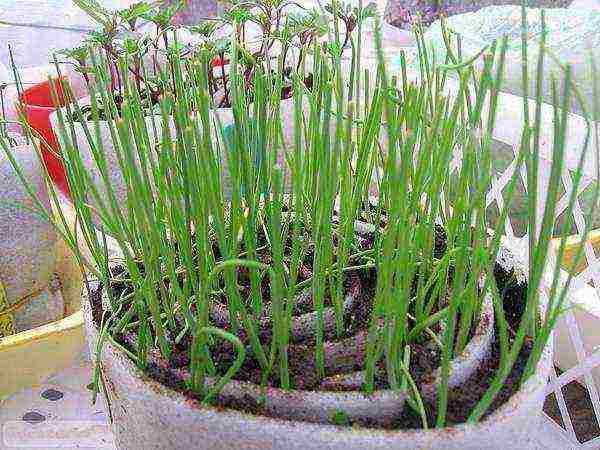
Seedlings of onion chives are very convenient to grow in a snail photo
The garden bed is prepared in advance, the soil is loosened well.Furrows are made 10 cm deep, watered and sprinkled with soil. Onion chives seedlings are planted in such grooves at a distance of 25-30 cm, moderately watered.
Dividing the chives onion bush
Over time, the plantings grow strongly, the yield decreases. Every 3-5 years, it is necessary to divide the bushes. You can plant it in spring or autumn. Water the bush abundantly, dig to a depth of 12-15 cm, remove the plant from the soil, divide it into several parts (at least 8 bulbs in each), plant, keeping a distance of about 30 cm. Water well, when planting in autumn it is advisable to mulch it with peat.
How to care for chives outdoors
Weeding and watering
In the first year after sowing, the sprouts need weeding from weeds, loosening the soil. Over time, the bush grows - the need for these measures disappears.
Water frequently, abundantly, but avoid waterlogging. From a lack of watering, taste is lost. In this case, cut off the "not tasty" leaves, then adjust the watering.
Top dressing
After the first cut, the plant should be fed. One of the following options can be added to 1 m² of area: 1 glass of ash each; manure solution (1 part per 15 liters of water); chicken manure solution (1 part per 20 liters of water). After adding organic matter, rinse the bushes with clean water. You can use mineral fertilizers.
Depending on the degree of depletion of plants, add 40 to 100 g of kemira, azofoska or nitrophoska per 1 m². If the soil is fertile, one top dressing is enough. Feed the depleted soils with mineral fertilizers after the 2nd and 3rd cut.
Harvesting

How to cut chives photo
During the season, 2-3 cuts are carried out, sometimes - 4. The cut is carried out when the leaves reach a length of 25-40 cm. The last cut should be carried out no later than the second half of September, so that the bushes have time to get stronger by winter.
The bulbs are also suitable for human consumption - with annual cultivation, cuttings are carried out during the season, and the bulbs are dug up in the spring of next year.
Chives varieties
Consider varieties ideal for successful cultivation in temperate latitudes:

Onion chives Bohemia photo
Bohemia - gives a bountiful harvest, is resistant to diseases, grows well in one place for about 5 years.
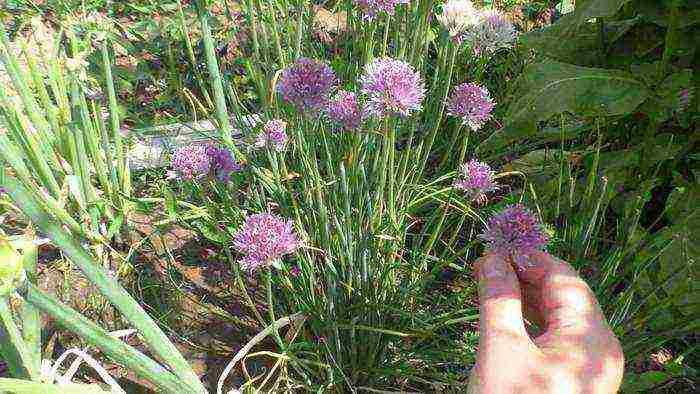
Onion chives honey plant photo
Honey plant - grown as a perennial plant, practically does not suffer from diseases.
Chemal is a spicy variety, grown as a 1-2 year old plant, subject to powdery mildew.
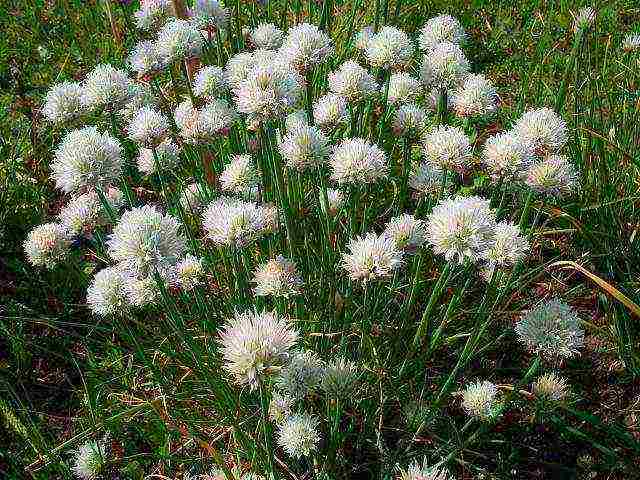
Onion Schnitt Elvi photo
Elvi - peduncles are white.
Diseases and pests of onion chives
The culture is rarely exposed to diseases and pests. Possible diseases: rust, powdery mildew; potential pests: moth-mining onion fly.
Preventive measures will help to avoid troubles:
- Seed pretreatment
- Short-term (for 10 minutes) placing the bulbs before planting in water at a temperature of 45 ° C
- Keep the excavated cuttings under bright sunlight for several hours.
Cut off plant areas affected by diseases and dispose of. If pests appear, spill the soil with saline, after 3-4 hours, be sure to pour clean water.
The simplest and most proven scheme for growing onions with seeds looks like this: in the first year, we grow onion sets from seeds. In the second year, we grow onions from the set.
If you start growing onion seedlings in early spring in an apartment on a windowsill, then you can have time to grow everything in one season.
Growing onion sets from seeds
Sevok can be grown from seeds. Onion seeds are black in color and therefore they are all called "nigella". When growing onions with seeds, it must be borne in mind that the seeds can be stored for no more than 3 - 4 years and they have a very poor germination capacity.
How to sow. Before sowing, it is advisable to soak the seeds in a growth stimulator for several hours. After that, wrap them in a damp cloth and keep them there until they hatch. Then the seeds are sown in the previously prepared grooves. Furrows are made with a depth of 2 - 3 cm, the distance between them is 20 cm.
Seedlings will appear in 8 - 10 days, they will resemble a long loop. After germination, be sure to weed, otherwise these loops will rise and will be very similar to ordinary grass.
What to feed. When seedlings appear, make the first feeding with nitrogen-containing fertilizers. It can be an infusion of mullein or talkers (infusion of herbs), and after the appearance of three true leaves, feed it with a complex min. fertilizer.
Please note: when growing onions with seeds, you can only feed the crops until mid-June. Water as needed, but not often. From the middle of June, watering and feeding the onions is no longer necessary.
Sevok is grown from such seeds.
Crop care. Seed onions are a completely cold-resistant plant and can be sown in open ground already at the end of April - beginning of May. Make crops thickened, because the blackberry has poor germination. It is best to thin out the plantings as you grow. It is necessary to thin out at least two times. At first, leave a distance of 1 cm between the shoots, and during the second thinning 5 cm.
When the feathers begin to fall on the ground, the onions can be scooped up and dried. To dry, the ray is tied in small bunches and suspended with the roots up. After drying, small bulbs with a diameter of less than 1 cm are sorted out and discarded. Such bulbs are difficult to preserve in winter, they dry out and become unsuitable for planting.
Such a trifle can be planted before winter. They are planted in October to a depth of 3 - 4 cm. Many of them will die in winter, and greens for food will grow from those remaining in early spring.
For large, good onions, the roots and dried feathers are trimmed and stored.
Another way to grow onions
They sow nigella in a different way. First, they get rid of the weeds in the garden. To do this, in early spring, cover the garden with old plastic wrap. When weed shoots appear, remove the film and loosen the soil well. Do not cover the bed at night with foil, the weeds will die overnight. Repeat this procedure one more time. After this double treatment, there will be no weeds in the top layer of the earth.
It is now impossible to dig up such a bed. When digging, weed seeds from the lower layers of the earth will again fall to the top and sprout.
Make grooves (2 - 3 cm) and 10 - 12 cm from each other with the handle of a shovel. Spill these furrows with a potassium permanganate solution to disinfect the soil. Then a solution of calcium nitrate (3 tablespoons per bucket of water). Mix 1 tbsp. a spoonful of nigella seeds and 1 tbsp. spoon of AVA fertilizer (dust fraction), add a glass of river sand there. Sow the resulting mixture into the grooves as if you were salt them.
At first glance, this method of growing onions with seeds seems complicated and even confusing. But as a result, we do not have to fight weeds, feed onions, thin out crops. We did everything at landing.
Before the emergence of shoots, the bed must be covered with a film, and after the emergence of shoots, change it to lutrasil. Until June, the bed should be covered with lutrasil, you can even water it over the shelter. At the beginning of June, the covering material is removed and in the future onions are grown as usual.
Onion from onion sevka
Growing onions
How to process sevok before planting. Before planting, the onion sets are processed as follows: Fold it in a plastic bag and sprinkle it with karbofos. Then hold it for 30 minutes in a solution of potassium permanganate. The onions are then ready for planting.
When to plant sevok. A small onion can be planted on May 8-10, and a larger one a little later.
How to plant. Sevok is planted at a distance of 10 cm between the onions. A distance of 15 - 20 cm is left between the rows, in order to make it more convenient to loosen the soil. Before planting, make grooves 3-4 cm deep and partially sprinkle them with sand. Onions are laid out in them and lightly sprinkled with earth.
When planting, place one AVA fertilizer under each bulb, then no additional fertilizing is required.
Growing onions. The arrows that appear must be removed immediately. You cannot cut feathers on greens, for this you should plant a separate bed.
It is necessary to water the onion at the root; it is not recommended to pour water on the leaves. It is even better to water between rows, water will still get into the root zone, and the onions themselves will remain dry. Watering is necessary only in dry weather and in the first half of summer. In the second half, it is much more important to loosen the beds, and in rainy weather it is better to cover the onion plantings with foil.
Planting sevka.
Harvest. When the feathers of the grown onions turn yellow and fall (usually in August), you can start harvesting. The collected onions must be dried, sorted out, cut off the dry feathers and only then put away for storage.
How to grow onions from seeds in one season
If desired, you can grow onions from seeds in one season. For this, seeds are sown at the end of February in boxes with soil. The row spacing is left 5 cm each, the temperature for seed germination should be within + 25 * C. When shoots appear, the box with seedlings can be put on the windowsill, there will be quite suitable conditions for it.
At the end of April, onions grow 3 - 4 feathers 10 - 15 cm high. When planting seedlings in ridges, they maintain a distance of 5 cm in a row and 30 - 40 cm between rows. Before planting, the leaves of the seedlings are shortened by a third and the roots are cut to two centimeters.
The soil around the seedlings is carefully compacted. A few days after planting, the plants are watered and loosened up the soil. Further care is the same as described above.
This is how the seedlings are grown on the windowsill.
I must say that onions grown by seeds in one season are rarely of good quality. Most often, it does not have time to ripen properly and therefore is poorly stored in winter.
Save article to:
Dear visitors of the "Dacha Plot", tireless gardeners, gardeners and flower growers. We offer you to pass the aptitude test and find out if you can trust the shovel and let you into the garden with it.
Test - "What kind of summer resident I am"
Share this article with your friends:
Today our conversation will be about growing onions from seeds.
Many people think that growing onion seedlings is a bit of a tricky business. But this is not difficult, I assure you !!!
To make everything work out, we adhere to all the rules.
Seedling onions are the best option, they allow you to grow a good harvest.
Growing onion seedlings from seeds at home.
This requires:
-
choose seeds;
-
prepare the soil in advance;
-
containers for seedlings: pots, box.
-
polyethylene film.
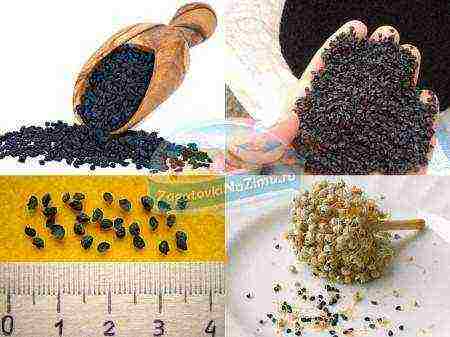
Basic rules for growing onion seedlings:
-
for these purposes, semi-sharp, sweet varieties are needed;
-
sow onion seeds at the end of February;
-
before sowing, we soak the seeds (like pepper seeds) for 8-10 hours in warm water, the water temperature should be 30-35 degrees.
-
then dry the seeds thoroughly.
-
for one square meter, the planting rate is 20 grams;
-
then cover with plastic wrap for excellent germination. We remove the film from time to time to provide the seeds with air;
-
after planting, water the seed, weed them;
-
after two months, onion seedlings, like pepper seedlings, are planted in the ground;
-
before disembarking the root, cut the top a little.
Pros of growing through seedlings
The best way to grow onions is through seedlings. In this way we grow onions in all regions of the country, with our favorite climate. Another very significant plus of this method is economy.

Basically growing onions from seeds we spend in large beds. If the beds are small, we also collect a fairly large harvest of onions from them. When using the seedling technique, we spend 3-4 times less seeds than with direct cultivation, and the yield is much higher.
Many gardeners use this method to grow the following types of onions:
-
Krasnodar;
-
kaba;
-
karatal.
-
lover;
-
the globe;
-
exibition;
-
Mavka;
-
amphora.
These varieties yield yields in the first year.
Another important plus of this method is that it does not require strong actions, is low-cost, and the result exceeds all expectations.
When using this method, we avoid small plants, which contributes to the good maturation of the bulbs. After harvesting, the bulbs can survive for approximately nine months, neither germinate nor rot.
At home, we grow onions by this process, now you can constantly pamper yourself, loved ones with fresh onions.
Growing onions from seeds in one season.
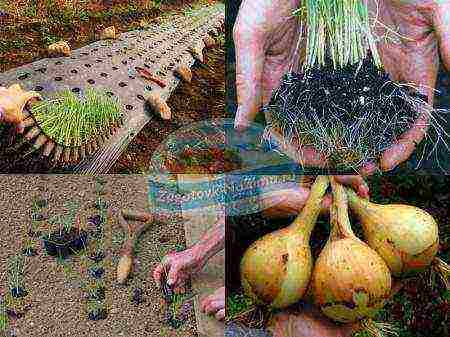
To grow onions, you need to wait a season - two, but luckily there was a way to do this in one season.
In order to get a bulb in one season, early varieties of onion hybrids are needed. We use mid-season varieties that are already "accustomed" to our climate.
Very popular varieties:
-
stuttgarter;
-
sissy;
-
alonso F1.
Onions love to bask in the warm rays of the sun, so they need the best sunny side of your site.
To prevent the bulbs from rotting, we do not plant onions for a couple of seasons in a row, in one place. It must take at least five years to plant the seed back in the garden. This way you will have an excellent onion crop.
Onions growing from seeds, when to plant?
Onion seedlings are planted in April, after the formation of the third leaf. We prepare the soil in the fall, fertilize, form rows. Then we outline the pits, plant the onions. From time to time we fertilize with organic and mineral fertilizers. Water the onions as soon as the earth dries up. We harvest in August, early September. To preserve the onion for a long time, dry thoroughly beforehand.
Thanks to the latest technology, there are already different varieties to grow onions from seeds - from sowing to harvesting in one season.
Types of onions
There are many types of onions that are not alike in taste, appearance, cultivation technology, and care.
The most common varieties of onions:
Chives bow
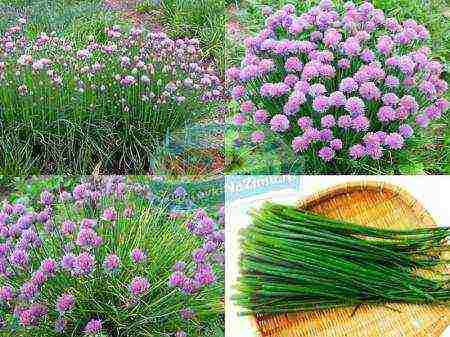
A magnificent plant, grows in any climate conditions, the green part is used.
Chives bow. Growing from seeds produced in small quantities. The sprouts are kept at -3-4 degrees. Due to their resistance to frost, onions are harvested before the beginning of January.
-
chives are grown from seeds. We plant in open soil, in greenhouses. Onions growing from seed, when to plant? We plant in early spring 50 * 25 centimeters, just try to sow it before winter. We grow it as one - two - or a perennial plant.
-
We often water chives onions, fertilize them with organic, mineral fertilizers.
-
chives - does not form an onion. In addition to other species, it has many leaves, a powerful root system.
-
onion chives contain many flavors, carotene, vitamin C.
Globo onion, Exible seed growing
These are new varieties - giants, of medium ripeness, grown from seeds. The weight of one onion reaches up to 1 kg. One of the largest hybrids. Sweet taste. They are odorless. Luke Globo and Exible are excellently grown from seed in open land through seedlings.
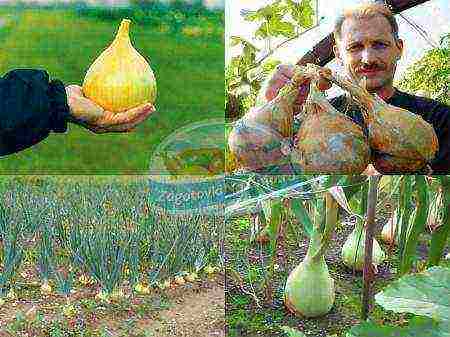
Onion growing from seeds
This is the most popular, favorite variety. Unpretentious, winter-hardy, high-yielding. Batun onion is a perennial plant that sprouts in one place for about 5 years. Grown for feathers. Instead of an ordinary bulb, it has a false bulb (thickened stem). Propagated from seed or by dividing the root.
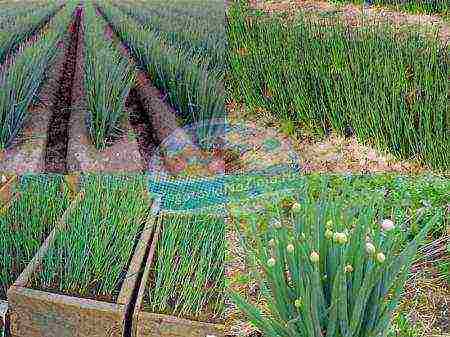
-
The seed ripens on the peduncle, then they must be collected or they are sown themselves.
-
We plant the seed in a nutritious soil well-lit by the sun. Batun requires space for a large number of sheets. Sow the seed from each other - 15 cm, between the rows - half a meter.
-
For the first time, we begin to cut feathers at the beginning of May. Has tasty, fragrant greens, we collect herbs for the season. In the fall, we do not touch the greens, as the culture is preparing for winter.
-
growing batun onions as an annual plant, we sow seeds at the end of April.At the beginning of September, there will be the first juicy, tasty harvest of leaves.
-
We plant a biennial plant at the end of July. As soon as the cold weather sets in, the seedlings will sprout and get stronger. Next year, from mid-summer to October, enjoy the greenery from your private plot.
-
Batun onion is resistant to drought, frost, diseases, therefore it is very valuable.
Leek growing from seed
A very famous plant species, it ranks third among all onion varieties. Growing technology - seeds. It grows well after sowing. Before sowing, disinfect the seed - put it in hot, then cold water in turn. To germinate much earlier, place the seeds on a damp gauze, in a warm place for three days, dry them a little. We do this procedure with seeds collected from the site. Purchased - no need to germinate. We sow seeds - in the second half of May.
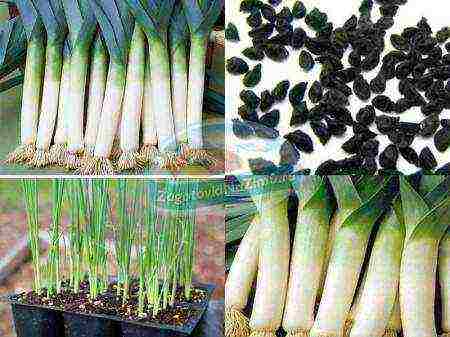
Growing leeks from seeds for the winter
Suitable for regions with cool climates. Sow seeds for seedlings in boxes. Sowing time: end of February - mid-April, in a bed under a film. If in winter, then illuminate the plant for twelve hours in a row (the place of dislocation is a windowsill, a heated greenhouse) at a temperature of 23-25 degrees. Cover with cling film until grown.
-
when shoots appear, remove the cover, lower the temperature to seventeen degrees. We will increase in a week to twenty degrees.
-
the right temperature will provide you with a good, high-quality harvest.
-
compost is an impeccable fertilizer for such a crop. To grow the root, from time to time, the grown greens are pruned at the level of ten centimeters.
-
before planting, we ventilate the seedlings, plant them in fertile soil 15 * 25 cm in May. Put compost in each hole. Before planting, shorten the leaves and the root system by a third.
-
watering fertile land during growth. We feed leeks with poultry droppings 1:20 or mullein diluted with water 1: 8.
-
this plant is in good harmony with carrots, we alternate planting beds. Carrots are a helper against an onion fly attack. We also plant leeks with strawberries, celery, beets.
Stuttgarten onions are grown from seeds.
Grown for greens, onions, sets. High productivity, it lies without losses for a long time. Weight - 50-84 grams. It tastes spicy, but you can eat. Sow seed in late April, harvest in August.
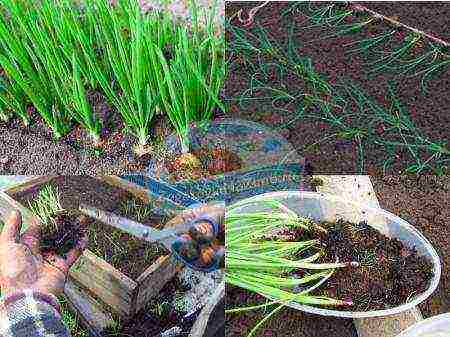
Stuttgarten risen onion cultivation from seeds. It is very simple to care for him, the main thing is not to damage the roots. We loosen the soil with a depth of 2-3 centimeters. In the first month, we monitor the humidity. We water 6 liters per square meter once a week. We feed the mullein 2-3 times a season, when 2-3 leaves grow and when the bulb is like a walnut. We bend the greens in July. This will allow the bulb to grow. As soon as the neck of the bulb is soft, start harvesting. If you miss this moment, then after 8-10 days it will be unusable.
Onions for greens growing from seeds - in early spring, at the end of winter, in general, you can sow for the winter. We sow the onion in 5-6 rows, the distance between them is 20 centimeters, the depth is 1-2 centimeters. Pre-soak the seeds, plant them swollen. We prepare the soil in the fall, loosen it before planting. We take care of onions in good faith, from time to time - we feed, water, remove weeds and loosen the ground. As you know, in the spring you want fresh vitamins and minerals. So let's get it right, and you will soon have fresh onion feathers that are much healthier than the bulb itself.
Chalcedony
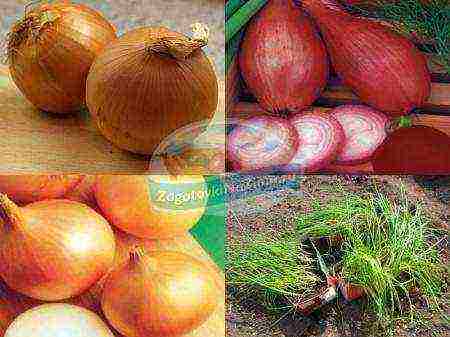
Onions of medium ripeness, ripening period 3.5-4 months. High yield, grown with bulb seeds. One season will give you about five kilograms of onions from one square meter. Chalcedony onions are yellow, spicy in taste, round in shape, perfectly preserved from April to May, try to prepare salted onions.
Shaman onion variety
It has an elongated bulb of 10-12 centimeters, brown-red in color.Thanks to this shape, we get a huge harvest from a small area, it is easier to cut into circles. We sow a seed in March, we grow seedlings, it is perfectly preserved for a long time.
Centaur - onion variety
Sweet taste. It is of a middle kind of ripeness, an annual, 95-106 days pass from the beginning of sunrise to the inclination of the feathers. Round, dense, mass from seeds - 80-100 grams, weight through seedlings - 250-300 grams. Dry scales of a dark yellow color. Juicy scales are white-cream. Harvest 10 kg per square meter. The variety is hardy to bad conditions, high-yielding, suitable for long storage without loss, ideal for making pickled onions.
Red braunschweig

Semi-hot, sweet taste. Weight 100-120 grams. Medium ripeness (from germination to feather tilt 95-118 days), annual, grown from seed. The shape is flat, round, dense. Dry scales of a dark red color. Juicy white-pink scales. Better to plant seedlings. The variety is resistant to diseases, the bulb is formed in one season, a good harvest.
Albion F1 - onion variety
Grown from seed over the summer. The bulb is pure white 3.5 centimeters, excellent semi-sharp taste. Early ripeness, not subject to long-term storage. We sow seeds in the ground at the end of April - beginning of May, pre-soak for 2-3 days in water, then for 8-12 hours in potassium permanganate.
Spirit F1 - onion variety
A very tasty, quickly ripe, fruitful hybrid, the onion is perfectly preserved. We sow seeds at the end of April. Loves warmth, does not spoil very quickly.
Oval - a variety of onions
Ripens 120-130 days after all sunrises, forms a bulb from seeds per year about 250 grams. In our area, it is better to grow seedlings.
Alice onion variety
Annual, we grow through seedlings. It keeps well. Medium ripeness variety of onions for long storage, has a high yield. The bulb is dense, medium-sized, round, weighing 130-150 grams. Pleasant, not very spicy taste, white onion. The husk is strong, firmly attached to the bulb, yellow. At the same time it ripens, has a favorable harvest, is resistant to diseases.
Water from pests with "tea":
Take a branch of bitter wormwood, a branch of aconite, dandelion leaves, a tomato (several small stepsons), hot peppers (2-3 ground large peppercorns). We put these components in a bucket, pour boiling water, insist for one day, strain. We dilute one, two liters of "tea" with a bucket of water (10 liters) and water the earth. Water a couple of times in one season.
If you liked our site, express your "thank you" by clicking on the buttons below.
